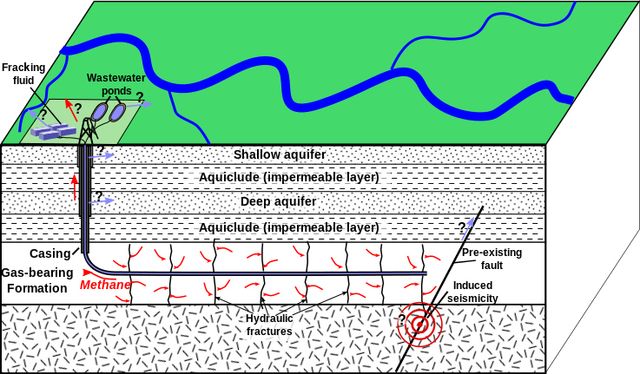By Philip Guelpa
9 July 2013
For years companies engaged in high-volume, horizontal hydraulic fracturing, also known as hydrofracking or simply fracking, used for the extraction of natural gas and oil from shale deposits, have claimed that this process is safe for the environment and for people. The results of new research published in the online edition of the Proceedings of the National Academy of Sciences (PNAS, 24 June 2013) lend strong support to the conclusion that toxic chemicals associated with hydrofracking are leaking from gas wells into surrounding ground water.
This finding corroborates what has long been obvious based on numerous documented instances of contamination in the drinking water wells of homes near hydrofracking drill sites, including the famous video of a homeowner igniting the water pouring from a tap, due to the high concentration of dissolved natural gas. Despite this evidence, the energy companies have asserted that their methods preclude leakage into the near-surface ground water. The new research blows this claim apart.
Fracking involves drilling a vertical well many thousands of feet below the surface to reach deeply buried bedrock deposits of shale, which contain trapped natural gas or oil (petroleum). Once the formation has been reached, the drill turns horizontal and extends out along the shale deposit. So-called “fracking fluid”, a witch’s brew of water laced with a range of toxic chemicals, including known carcinogens, and sand, is injected down the well under high pressure. This fluid then spreads out along the horizontal bore and fractures the shale, releasing the trapped natural gas or oil. The resulting mixture is then returned to the surface via the vertical shaft. The gas or oil is separated out, leaving millions of gallons of contaminated water for each well.

Disposal of the contaminated wastewater is a significant problem in its own right, since most municipal wastewater treatment facilities are not equipped to handle the toxic chemicals, which sometimes even include radioactive elements drawn out of the bedrock. This aside, however, the industry has consistently claimed that a combination of metal pipes and cement casings for the vertical portion of the well prevents any leakage of toxic materials as they traverse the near-surface deposits that contain ground water. Hence, according to the companies, all claims that contamination of ground water is due to hydrofracking must be false.
The newly released study demonstrates that, with a very high degree of statistical confidence, the location of ground water contamination by gases associated with hydrofracking is correlated with the locations of fracking wells. The researchers analyzed samples from 141 drinking water wells located in northeastern Pennsylvania, an area of extensive hydrofracking activity. For those located close to natural gas wells (defined as less than one kilometer away), concentrations of methane, ethane, and propane were found to be significantly higher than for those water wells located farther away.
“Methane was detected in 82% of drinking water samples, with average concentrations six times higher for homes <1 km from natural gas wells (P = 0.0006). Ethane was 23 times higher in homes <1 km from gas wells … propane was detected in 10 water wells, all within approximately 1 km distance.”
Please read full report here
No comments:
Post a Comment